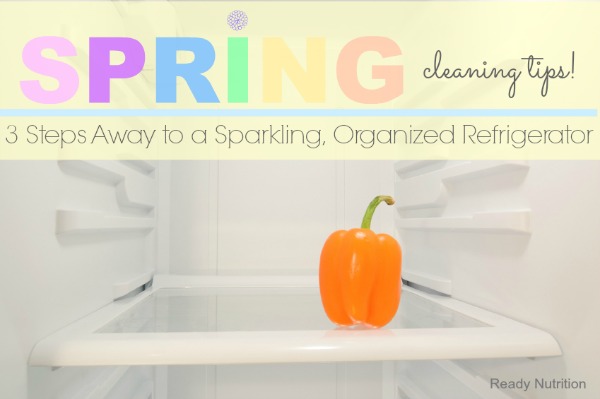I love the month of February, and it isn’t because of Valentine’s Day. I love it because it is a month dedicated to organizing the kitchen – the room in which I spend practically all of my time. There is no denying that a well-organized kitchen can save you time and money and nowhere is that more apparent than with the refrigerator. So let’s grab a trash bag, your favorite cleaner, and a few rags and let’s tame the beast.
1. Deep Clean. Like with the pantry, the only way to get the refrigerator clean is to dig in, so go shelf by shelf and clear everything out. Open the scary containers in the back and remove the science projects that started sometime around Christmas. Wipe the condiment jars down and toss out anything that is past its date or just doesn’t look or smell like it is supposed to any more. If you are a gardener, take decomposing veggies outside to their designated compost area. If you aren’t into gardening, take the bag immediately to the trash and cover it with a lid.
2. Scrub those shelves. This is my favorite part of cleaning out the refrigerator. I love to see something dirty sparkle when I am done with it. Grab your favorite cleaner and wipe each shelf, bin, and rack clean. This all-purpose spray is one of my favorites. Don’t forget to use a separate rag to dry the shelves.
Tip: Warm soapy water is an excellent refrigerator cleaner and so is a spray bottle filled with vinegar and water.
3. Reorganize. The way you put your food into the refrigerator matters. A rule of thumb to follow is that items that don’t need prep work, such as leftovers or prepared foods, should be placed at the top or near the top. Everything else is placed according to the temperature it needs to be cooked at. Foods that require the highest temperature when cooked, such as meat, should be placed near the bottom. Organizing this way prevents any cross contamination that could occur like when your meat drips onto your produce.
Use the following bullets as an additional resource when putting your food back into the refrigerator.
- Meat – Chicken, pork, and beef should be placed at the bottom of the refrigerator because it is the coolest location, and it will keep those pricey items from spoiling too quickly.
- Deli meats and cheeses – Deli meats should be stored where it is coldest in your refrigerator, which is at the bottom and towards the very back. If your refrigerator has a deli drawer, use it because it controls the temperature and humidity levels.
- Leftovers – Leftovers should be kept on the left side of the refrigerator at eye level so you can see them, which will help keep the science projects at bay. (Remember left goes left.) Throw away leftovers after three days. If it hasn’t been consumed by then, chances are they won’t be.
Tip: Store leftovers in clear containers so you can what is in them or label them when you put them in the refrigerator.
- Dairy and Eggs – Eggs and butter should be placed together. They can go in a dairy compartment if you have one or on the top shelf.
- Fruits and Vegetables – Produce should be kept on a lower shelf or in the crisper if your refrigerator has one.
Tip: Keep fruit and vegetables in separate spaces. Fruit need a dry environment while vegetables need humidity. If your refrigerator doesn’t have separate drawers, consider using drawer separators, like this blogger did.
Need more space? Citrus fruits, onions, tomatoes, potatoes, and winter squash don’t need to be refrigerated. Consider having a space in your pantry dedicated to onions and potatoes. A pretty bowl is a wonderful storage place for citrus fruits.
Condiments and dressings – These items are perfect candidates for the refrigerator door because they can handle the slight temperature variations when the door is opened and closed.
Did You Know? Mustard and ketchup can live outside the refrigerator for up to 1 month before spoiling.
Beverages – Drinks should be kept at eye level, especially milk because it spoils quickly. If your refrigerator has storage allocated for cola cans, use it. Never store your milk in the side door because it will spoil faster.
Tip: Point expiration dates upwards and out where you can see them.
I love the idea of using containers to organize a refrigerator. It keeps things neat and tidy and prevents any sort of leakage onto other food.
The local dollar store also has containers that can be used for food storage. Here is an example found on the domestic geek blog.
(Source)
Now that you have a clean and organized refrigerator, make it a habit to clean it out once a week or circle a day on your calendar twice a month that reminds you to clean it. A lot less time and energy goes into maintaining a clean state than actually having to do a big clean when the refrigerator starts to look and smell like an untamed beastie. I clean mine out every Saturday morning before the waste collection truck comes by.
This article was originally published at Ready Nutrition™ on February 19th, 2015










